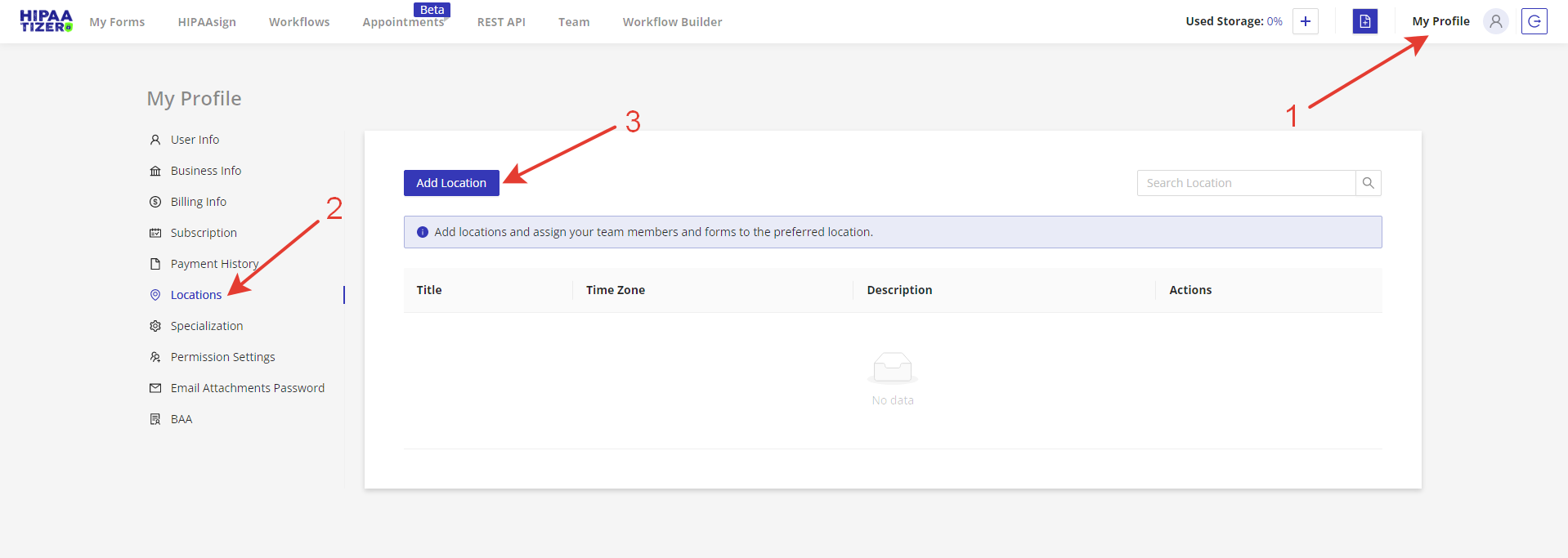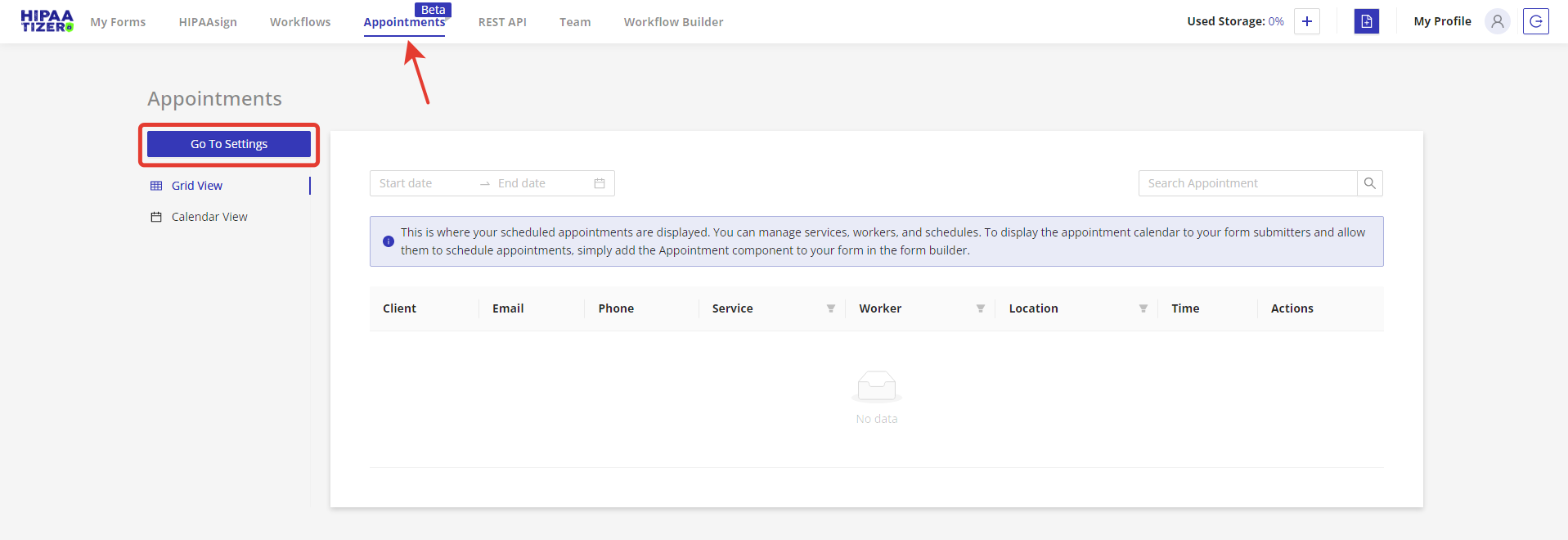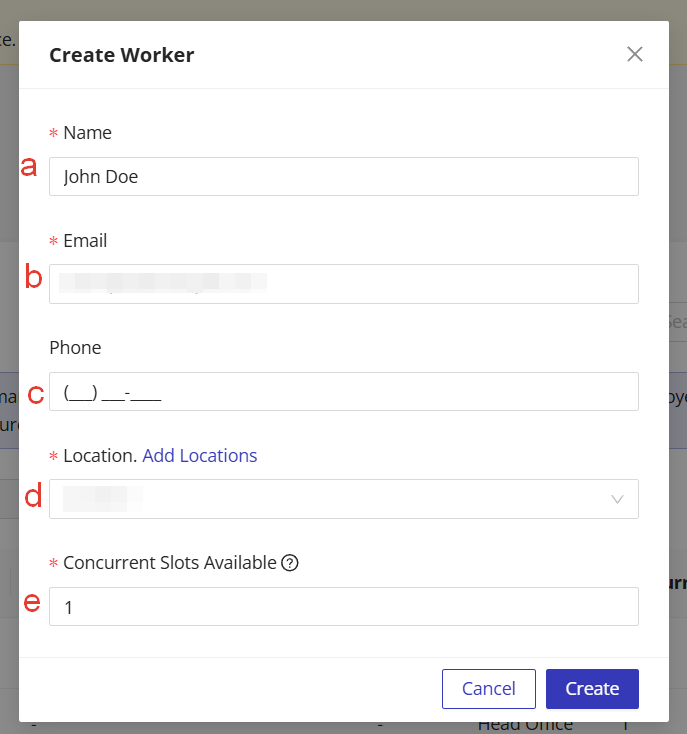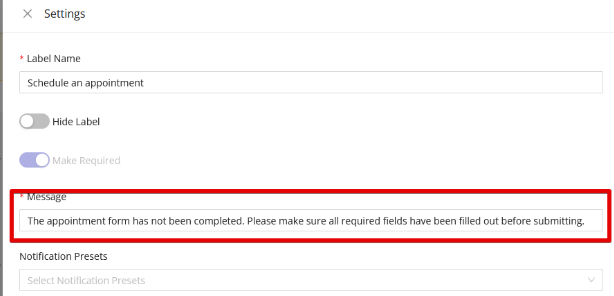HIPAAtizer is a powerful platform that enables you to add appointment scheduling to your forms, streamlining the management of medical appointments. With HIPAAtizer, you can set up appointments for your office locations, define services, workers, and their availability. This guide will walk you through the process of creating, editing, and managing appointments in HIPAAtizer.
Before you start creating and managing appointments, ensure that you have provided information about your office location. To do this, follow the steps below:

- Log in to your HIPAAtizer dashboard.
- Navigate to the “My Profile” menu at the top (1), then go to the “Locations” tab (2) and click “Add Location” (3).
- Enter the following information:
a. Location Title: For example, “Dental Clinic 5th Av.”
b. Email address
c. Phone
d. Address
e. Timezone (The system will automatically detect your current timezone, but you can change it if needed.)
f. Description (optional) - Click the “Create” button to save your location.

Now that you have set up your office location, you can proceed with creating and managing appointments in HIPAAtizer.
Company-wide Appointment Settings
To set up company-wide appointment settings, navigate to the “Appointments” menu at the top of your HIPAAtizer dashboard. You will need to manage the following:

- Services: Manage the services you offer, such as “Teeth Whitening” or “Braces.” You can add, edit, or remove services as needed to reflect the offerings of your business.
- Workers: Add, edit, or remove employees who provide your services. Assign them to specific services to ensure seamless scheduling.
- Schedules: Manage the scheduling presets for your services and workers. Create and customize schedules for each service and worker, and set specific availability times to ensure efficient scheduling.
- Notifications: Edit or create custom email templates that will be sent to you and your clients when appointments are created, updated, or deleted.
- Overrides: Use this feature to add dates when your availability deviates from your normal weekly hours. For example, you can use overrides for public holidays. This allows you to set custom availability for specific dates, ensuring accurate scheduling and avoiding overbooking.

Now that you have configured your company-wide appointment settings, you can proceed with creating and managing appointments in HIPAAtizer.
Creating a Service
To create a new service, follow the steps below:
- Navigate to the “Appointments” menu at the top of your HIPAAtizer dashboard.
- Click on “Services,” which will direct you to the list of available services.
- Click the “Create Service” button to start creating a new service.

- Enter the following required information for your new service:
a. Title: Provide a descriptive name for the service (e.g., Teeth Whitening).
b. Duration: Indicate the length of the service in minutes.
c. Booking availability: Set a date range in which services can be booked in advance. When a date range is set, services cannot be booked beyond the set date range. If you do not need to limit the date range, choose the ‘Indefinite’ option.
d. Optionally, you can also set the following advanced settings for your service:
i. Time Block Before: Specify the number of minutes you want to block before the service, which can be used as a buffer or preparation time.
ii. Time Block After: Specify the number of minutes you want to block after the service, which can be used as a buffer or cleanup time.
iii. Limit of Appointments per Day: Set a maximum number of appointments allowed per day for this particular service to prevent overbooking.
iv. Set Minimum Booking Notice: Define the minimum amount of time required before an appointment when clients are unable to schedule an appointment.
- After filling in the necessary information, click the “Create” button to create your new service.

Please note that the booking windows are tied to specific services, so you will need to edit the ‘Date Range’ field for each service that needs its window extended.
Now you have successfully created a service in HIPAAtizer. You can continue to add more services, edit existing ones, or remove them as needed.

Creating a Worker
To create a new worker, follow the steps below:
- Navigate to the “Appointments” menu at the top of your HIPAAtizer dashboard.
- Click on “Workers,” which will direct you to the list of available workers.
- Click the “Create Worker” button to start creating a new worker.

- Enter the following required information for your new worker:
a. Name: Provide the full name of the worker.
b. Email: Enter the worker’s email address, which will be used for communication and notifications.
c. Location: Assign the worker to a specific office location.
d. Concurrent Slots Available: Indicate the maximum number of appointments the worker can handle simultaneously. This helps prevent overbooking and ensures proper scheduling.
e. Optionally, you can also provide the worker’s phone number for additional contact information. - After filling in the necessary information, click the “Create” button to create your new worker.

Now you have successfully created a worker in HIPAAtizer. You can continue to add more workers, edit existing ones, or remove them as needed.

Creating a Schedule
To create a new schedule, follow the steps below:
- Navigate to the “Appointments” menu at the top of your HIPAAtizer dashboard.
- Click on “Schedules,” which will direct you to the list of available schedules.
- Click the “Create Schedule” button to start creating a new schedule.

- Enter the following required information for your new schedule:
a. Title: Provide a descriptive name for the schedule (e.g., Regular Working Hours). - Optionally, you can add notes for your reference.
- Set the Weekly Hours:
- For each weekday that you want to make a working day, check the corresponding checkbox.
- Specify the “From” and “To” hours for each working day (b, c).
- You can define several working intervals for each day by clicking the “Add Row” button and entering the additional “From” and “To” hours.
- After filling in the necessary information, click the “Save” button to create your new schedule.

Now you have successfully created a schedule in HIPAAtizer. You can continue to add more schedules, edit existing ones, or remove them as needed. This will help you manage the availability of your workers and services more efficiently.

Creating a Date Override
To create a new date override, follow the steps below:
- Navigate to the “Appointments” menu at the top of your HIPAAtizer dashboard.
- Click on “Overrides,” which will direct you to the list of available date overrides.
- Click the “Create Date Override” button to start creating a new override.

- Select all schedules for which this override will be applied. You can choose multiple schedules by holding down the Ctrl key (or Command key on Mac) and clicking on each desired schedule.
- Select the date range when the override will be applied by choosing the start date and end date from the calendar.
- Choose one of the following options for the selected date range:
a. Check the “Unavailable” checkbox if you want to make this date range a holiday or non-working period for the selected schedules.
b. If you want to specify new working hours for this date range, leave the “Unavailable” checkbox unchecked and enter the new “From” and “To” hours for each working day within the date range. - After filling in the necessary information, click the “Create” button to create your new date override.


Now you have successfully created a date override in HIPAAtizer. You can continue to add more overrides, edit existing ones, or remove them as needed. This will help you manage deviations from your regular schedule, such as holidays or special events, ensuring accurate scheduling and avoiding overbooking.

Creating Notification Templates
To create notification templates for appointments, follow the steps below:
- Navigate to the “Appointments” menu at the top of your HIPAAtizer dashboard.
- Click on “Notifications,” which will direct you to the list of available notification templates.
- Click the “Create Notification Template” button to start creating a new template.

- Each template contains 6 email templates for different scenarios:
- Notification for Business: Appointment Created
- Notification for Business: Appointment Updated
- Notification for Business: Appointment Deleted
- Notification for Client: Appointment Created
- Notification for Client: Appointment Updated
- Notification for Client: Appointment Deleted

- Use the WYSIWYG editor to customize email templates. You can use the following appointment variables in your templates to personalize the content:
- ${business-name}
- ${business-phone}
- ${business-email}
- ${date}
- ${time}
- ${name}
- ${first-name}
- ${last-name}
- ${email}
- ${phone}
- ${location}
- ${service-name}
- ${worker-name}
- ${reschedule-link}
- ${cancel-link}
- After customizing the email templates, click the “Save” button to create your new notification template.

Now you have successfully created a notification template in HIPAAtizer. You can continue to add more templates, edit existing ones, or remove them as needed. This will help you manage the communication process with your clients and staff, ensuring that everyone stays informed about appointment changes.

Adding the Appointment component to your form
To add the appointment component to your online form in the drag-and-drop form builder, follow the steps below:
- Drag the “Appointment” component from the “Components” menu on the left-hand side of the form builder to the desired location on your form.

- Change the label of the component by clicking on the “Label” field and entering your desired text.

- Change the text of the additional message row by clicking on the “Message” field and entering your desired text.

- Choose a notification preset from the “Notification Preset” dropdown menu. This will determine the content of the email notifications that you and your clients receive.

- Enable reminders (this optional) by clicking on the “Enable reminders” toggle switch (1). Then reminders are enabled, you can choose when you want to submit your appointment reminder notification (2).

- Choose the locations for which this appointment component can be used by clicking on the “Locations” field and selecting the desired location(s) from the dropdown menu.

- For each selected location, select the related worker(s), schedule(s), and service(s) by clicking on the “Worker”, “Schedule”, and “Service” fields and selecting the desired options from the dropdown menus.

To add an additional row with location, worker, schedule, and service, click on the “Add Row” button (1) below the table. If you want to add an additional location/worker/schedule/service or edit the already existing, you can do so by clicking the related buttons: “Edit Locations” (2), “Edit Workers” (3), “Edit Schedules” (4).

- Rename the steps of the appointment component by clicking on the “Edit” icon next to the related field and entering your desired text.

- Mark the “First Name”, “Last Name”, and “Phone” fields as “Required Contact Information” by clicking on the “Required” toggle switch next to each field. Please note that the “Email” field is always required.

If you have already created a field in your form for any of the required contact information, you can additionally connect it to the appointment component by clicking on the “Select from Form Fields” button and selecting the desired field from the dropdown menu. If you have not created any fields they will be generated automatically.

Once you have completed these steps, your appointment component will be ready to use on your online form in the drag-and-drop form builder. You can customize it further by adjusting the appearance, settings, and layout options as needed.
Still have questions? Contact us